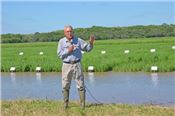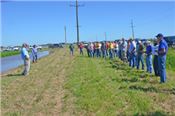|
Louisiana Rice Acreage Down 8 Percent In 2017

LSU AgCenter rice breeder Steve Linscombe talks at the Vermilion rice field day on May 25
about new varieties and hybrids under development.
Photos by Bruce Schultz/LSU AgCenter
LAKE ARTHUR, LA.
This year’s Louisiana rice planting, estimated at 400,000 acres, is 8 percent less than last year, according to LSU AgCenter rice extension specialist Dustin Harrell.
AgCenter estimates for the 2016 crop were 432,168 acres.
Harrell told farmers at a rice field day in Vermilion Parish on May 25 that the 2017 crop got an early start because of warm weather.
Some rice was planted in February, and rice in those fields have already headed. “We’ll probably be two weeks earlier on our harvest,” he said.
Flooding after planting caused some problems that could result in yield losses. Fertilizer may have been lost from high water, he said, if nitrogen was applied on flooded fields.
A new product will be on the market in 2018 that will prevent nitrogen losses better than Agrotain, Harrell said.
Andrew Granger, LSU AgCenter county agent in Vermilion Parish, said prices have increased slightly because of a decrease in Arkansas rice acreage.
AgCenter entomologist Blake Wilson said Dermacor is effective protection against rice water weevils but some farmers may choose not to use the $18-an-acre seed treatment to save money.
Cruiser and Nipsit are less expensive alternatives, he said, and like Dermacor, they protect against other insects but not stem borers.
Wilson said he expects the Mexican rice borer will become more of a problem to farmers in the eastern part of the rice-growing area as populations build from the west.
Some Cercospora disease has been found, probably after surviving on rice during the warm winter, said AgCenter plant pathologist Don Groth. If left untreated, Cercospora could become uncontrollable.
Granger said Cercospora seems to be localized, with not much of the disease in the northern and western parts of Vermilion Parish.
Some farmers have been unable to obtain the fungicide Sercadis, but the alternative product, Elegia, is also effective, Groth said.
AgCenter weed scientist Eric Webster said the herbicide benzobicyclon has been labeled for use in California. The product, which controls sedges, grass and broadleaf weeds in flooded rice, probably won’t get approval for Southern states until 2019, he said.
Another new herbicide, Loyant, will be available next year, Webster said. It effectively controls aquatic grasses and broadleaf weeds. “It has a lot of potential in the weeds we see in a rice-crawfish rotation,” he said.
AgCenter rice breeder Steve Linscombe said the AgCenter could release a rice hybrid within two to three years.
The Lounsberry Farm, where the field day was held, has provided land for variety trials and experimental line testing for 33 years, Linscombe said.
Check-off research funds provide money for conducting research that originates from the H. Rouse Caffey Rice Research Station. “I can promise you we wouldn’t be doing this research if not for the check-off funds,” Linscombe said. ∆

LSU AgCenter weed scientist Eric Webster talks at Vermilion Parish rice field
day on May 25 about new herbicides that will be available to farmers this year and in 2018.
Photo by Bruce Schultz/LSU AgCenter
|
|